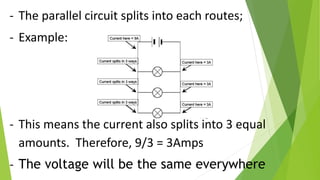OHMS LAW.pptx
- 1. OHMS LAW Mr. S MARIA ANTONY
- 2. - Current: The path an electric current follows - Unit for current is amp - An ammeter measures the amount of current flowing past a certain point
- 3. Understanding OhmŌĆÖs Law OhmŌĆÖs law may be easier to understand with an analogy. Current flowing through a wire is like water flowing through a hose.
- 5. Increasing voltage with a higher- volt battery increases the current. This is like opening the tap wider so more water flows through the hose.
- 6. Increasing resistance reduces the current. This is like stepping on the hose so less water can flow through it.
- 7. Increasing the resistance, decreases the flow of currentŌĆ”
- 9. A series circuit is a circuit in which resistors are arranged in a chain, so the current has only one path to take. The current is the same through each resistor.
- 10. You need to be aware of the following rules to work through the next questions. - Current in a series circuit is the same at all parts in a circuit. In a series circuit, the total, or sum of the voltages across all the components will equal the voltage across the cell/battery. - The total voltage supplied by the cell is 12V. There are three lamps connected in series, so 12/3 = 4V.
- 11. - The parallel circuit splits into each routes; - Example: - This means the current also splits into 3 equal amounts. Therefore, 9/3 = 3Amps - The voltage will be the same everywhere
- 12. Questions: ’üĄ The label on the battery says 6V. If we connected a voltmeter across each lamp, what would the readings be? ’üĄ At lamp 1 - ________V ’üĄ At lamp 2- ________V ’üĄ At lamp 3- ________V
- 13. Questions ’üĄ What type of circuit is this? ’üĄ What voltage will load 1, 2 and 3 have ? ’üĄ What current will Load 1, 2 and 3 have? 9 V L1 L2 L3












